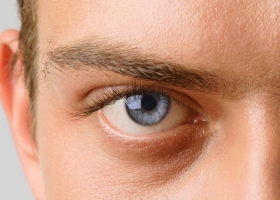December 25th, 2013
- Invented a method that helps people often blushing
- Endometrial hyperplasia
- Diseases of metabolic and endocrine diseases
- The formula of sodium iodide
 Exophthalmos ( exophthalmia ) - A condition in which a person has one or both eyeballs move forward, while there may be a deviation in the direction of the eyeballs.
Exophthalmos ( exophthalmia ) - A condition in which a person has one or both eyeballs move forward, while there may be a deviation in the direction of the eyeballs.
How does exophthalmos?
Symptoms appear only exophthalmus offset eyeballs, but their sizes are normal. Goggle-eyed man is seen in a number of diseases - if Grave's disease . thrombosis and brain aneurysms . tumors of the orbit and brain . inflammation in the orbit and sinuses and etc.
The so-called endocrine edematous exophthalmos seen in people suffering from Graves' disease. With the development of the disease in man there is an increase of the thyroid gland, muscle weakness, lethargy and symptoms hyperthyroidism . In the body of the patient hyperthyroidism occurs abnormal protein production, under the influence of which the thyroid gland is functioning too intense.
In medicine it is determined putative and true exophthalmos. Manifestations imaginary exophthalmos observed in people who have an innate asymmetry of the eye sockets, some abnormalities of the skull, eye slit expanded, increasing the size of the eyeball. In turn, the true exophthalmos divided into inflammatory and non-inflammatory tumor.
Bulging eyeball a person with exophthalmos can be virtually invisible, and strongly expressed. In marked buckling may experience hyperthermia and edema of the eyelids, swelling of the conjunctiva. Depending on the degree of exophthalmos eyeball can either be mobile or to some extent lose mobility. If the eyeball does not move or its mobility is very limited, the doctor may suspect the presence of a strong inflammation in the eye socket or the intensive development of the tumor. Visual impairment may occur, depending on how strongly expressed the pathological process.
In some forms exophthalmos patient increased intraocular pressure. This is possible with edematous form which arises spontaneously or after removal from the human thyroid gland. In this case, the patient may complain of recurrent orbital pain, decrease in visual acuity.
Pulsating exophthalmos seen protrusion of the eyeball and its ripple. Development of false pulsating exophthalmos occurs in patients with brain tumors, aneurysms of the orbit and the internal carotid artery. True pulsating exophthalmos - the result of injuries and rupture the walls of common carotid artery. As a consequence, there is penetration of arterial blood into the upper orbital vein, it is expanding its walls and protrusion of the eye sockets. When a pulsating proptosis patient may suffer from headaches, occasionally manifesting tinnitus.
The emergence of intermittent exophthalmos associated with a number of eye diseases. It occurs when a person tilts his head.
The consequence of the displacement of the eyeballs become defeated the eye muscles, which ultimately leads to strabismus . By moving the eyeballs and the limited mobility of a person is often seen expressed diplopia . Also in severe displacement of the eyeballs tight contact between the upper and lower eyelid is impossible. As a result, not moistened cornea sufficient, and the patient may develop keratopathy Ie degenerative processes in the cornea, leading to a serious inflammatory processes. The most serious complication of exophthalmos is a compression of the optic nerve, which occurs due to elevated intraocular pressure. As a result, blood flow is disturbed and the signal conduction along nerve fibers. The nerve may be completely lost, and the person develops blindness.
Why appears exophthalmos?
 Reasons exophthalmos may be associated with the development of certain diseases. Proptosis often develops as a result of endocrine ophthalmopathy . This disease is usually observed sided exophthalmos. Causes of unilateral exophthalmos often associated with various diseases of the eye. Less unilateral exophthalmos occurs in hyperthyroidism and other common diseases.
Reasons exophthalmos may be associated with the development of certain diseases. Proptosis often develops as a result of endocrine ophthalmopathy . This disease is usually observed sided exophthalmos. Causes of unilateral exophthalmos often associated with various diseases of the eye. Less unilateral exophthalmos occurs in hyperthyroidism and other common diseases.
Manifestations pucheglazija may be associated with inflammatory diseases of lacrimal glands and fatty tissue of the orbit with the orbital vessels vasculitis. Also, this symptom can be observed in tumors of the eye socket, varicose veins of the orbit, after the injury, the result of which is bleeding behind the eyeball.
Exophthalmos can also be one of the symptoms of congenital glaucoma . unilateral myopia . hypothalamic syndrome . Hydrocephalus . Buckling of the eyeball may be an early sign of orbital tumors, which may have both benign and malignant character.
Disease exophthalmia - Sometimes referred to as Grave's disease In which a man says strong bulging eyes, noticeable even in the photo. Goggle-eyed at the person with Graves' disease does not develop due to the increase of the eyeball. Graves' disease manifests itself in humans as a result of autoimmune processes that occur in people with a hereditary predisposition, under the influence of certain internal and external factors. Goggle-eyed people can be manifested in the failure of hormonal, endocrine diseases, viral diseases due to exposure to radiation, and others. Most often, Graves' disease develops in women exophthalmia in children is rare.
How to get rid of exophthalmos?
Before proceeding directly to the treatment of exophthalmos, you must establish the correct diagnosis and determine why an individual develops this condition. The diagnosis is established during ophthalmologic examination, as well as through a detailed survey of the patient, who must tell in detail about the features of a specialist of the disease. Practiced a special procedure called exophthalmometer. In the course of such an examination using special mirrors specialist assesses especially the location of the eyeballs. If necessary, also practice computer or magnetic resonance imaging. Information obtained in the course of these studies can more accurately determine the changes.
To confirm the diagnosis, sometimes a specialist assigns the patient for laboratory tests to establish the levels of thyroid hormones.
Treatment exophthalmos depends on how changes are expressed, and the cause of this symptom. How to treat exophthalmos, the doctor will determine after the establishment of an accurate diagnosis. If a patient is diagnosed endocrine ophthalmopathy , The treatment is carried out by correcting pucheglazija thyroid functions. In such a case is assigned to treatment glucocorticosteroid drugs. It should be understood that in this case it is not necessary to practice the treatment of folk remedies to not exacerbate the condition of health.
If a person is marked inflammatory process, necessary to carry out anti-inflammatory treatment, as well as the drugs that reduce the toxic effects of inflammatory processes in the body. Sometimes the doctor may decide to treat surgically. So, when expressed proptosis held eliminate compression of the optic nerve. If the damage of the cornea is possible partial or complete crosslinking century.
In the presence of cancer pathology patients underwent surgery and subsequent radiation therapy or chemotherapy.
If the diagnosis " false exophthalmos "And you have a small physical bulging eye treatment is not carried out, but the sick shall be regularly monitored.
When Graves' disease treatment prescribed by the physician and endocrinologist. First of all the patient has to take a course of drugs that help suppress the activity of the thyroid gland. Initially, the doctor prescribes high doses, they later gradually reduced. What is important is constant monitoring of thyroid hormones. The complex treatment includes intake of glucocorticoids, immunomodulators.
In the absence of efficacy after treatment medicines can be performed surgery. During this operation removes part of the thyroid gland. Also, the treatment of Graves' disease may be carried out by application radioiodine . However, this method is practiced for the treatment of the elderly.
No comments:
Post a Comment